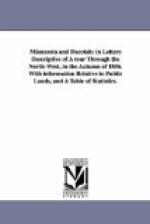“Broken rolling ground to camp, a mile off the Red River trail, and near a small wooded lake. Two small brooks have to be crossed in the interval, and being somewhat deep and with abrupt sides, are troublesome crossings.
“June 20. Rolling prairie country, with small marshes and ponds to a tributary of South Branch. Swift running stream, gravelly bottom, fifteen feet wide, three to four feet deep; with care in selection good crossing was obtained for the wagons; a wooded lake is a short distance to the right of trail.
“Small rivulet, whose banks are marshy and soft.
“Prairies, with small marshes and ponds to a swift running brook, six feet wide.
“Prairie to Pike Lake and camp of St. Grover; a handsome lake of about a mile in diameter, said to abound in pike; well wooded on its south border; grass, water, and wood, for camping, abundant and good.
“Rolling prairie with knolls; several ponds and marshes, with an intervening brook about six feet wide, and rather difficult of passage, from the abruptness of its banks, to a small brook, the outlet of a small and partially wooded lake or pond.
“Rolling prairie, with grassy, swelling knolls, small ponds and marshes, to Chippeway River; camp of odometer wagon on edge of river; water and grass good; no wood.
“June 24. Crossed Chippeway River, one hundred and twenty-four feet wide, three to six feet deep; goods boated over, and the animals swimming; wagon hauled through the water by a rope attached to the tongue, and with the aid of the mules; camped on Elk Lake, a small and pretty lake, well wooded, and with luxuriant grass; good water.
“June 25. Trail passes over prairies with a rich heavy grass (this is a hundred miles west of the Mississippi River), about eighteen inches high, winding between wooded lakes to a heavy ravine, with a small and sluggish rivulet in its bottom; sides steep, and laborious for the wagon train.
“Prairie sloping towards the western branch of the Chippeway River; a stream when crossed, about one hundred and forty feet wide, three or four feet deep, with a marked current and firm bottom; no wood.
“Camp on a small lake, fairly wooded, with luxuriant grass, and good water.
“June 27. Undulating prairie, rich soil, covered with a heavy growth of grass, with small ponds and marshes; woods continue in sight a short distance on the left of Elbow Lake, a well wooded lake, of form indicated by its name.
“Rolling prairie, with two bad sloughs, to Rabbit River, which is crossed with the wagon with but little difficulty, where it issues from a small lake. It is a small stream, but spreads out from one hundred to three hundred feet, with marshy borders; camp on the small lake, with good grass, wood, and water.
“June 28. Rolling ground, with small ponds and marshes, to a small brook twelve feet wide; the Bois des Sioux prairie, a smooth, flat prairie, without knoll or undulation— an immense plain, apparently level, covered with a tall, coarse, dark-colored grass, and unrelieved with the sight of a tree or shrub; firm bottom, but undoubtedly wet in spring; small brook, when the train made a noon halt.




